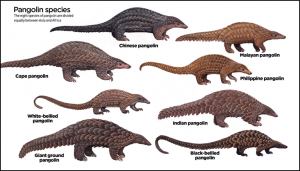Pangolin Trafficking Declined:

Global trafficking of pangolin scales has sharply declined since 2020, primarily due to COVID-19-related disruptions, sustained law enforcement actions, and evolving smuggling tactics, according to the Wildlife Justice Commission (WJC) report.
- There are 8 species of pangolins: 4 in Africa (Black-bellied, White-bellied, Giant Ground, Temminck’s Ground) and 4 in Asia (Indian, Chinese, Sunda, Philippine pangolins).
- Pangolins live in tropical forests, grasslands, and agricultural areas, and are found close to human settlements. The Indian pangolin is common across India, Nepal, Sri Lanka, and Bangladesh.
- They feed primarily on ants and termites, contributing to pest control and soil aeration, making them crucial for ecosystem balance.
- They are heavily targeted for illegal trade in Asia, where their scales are used in traditional medicine and meat is considered a delicacy. Additionally, habitat loss has worsened their decline.
- Conservation Status:
- Indian pangolin is Endangered on the IUCN Red List.
- The Chinese pangolin is listed as Critically Endangered.
- Both are protected under Schedule I of India’s Wildlife (Protection) Act, 1972.
- All 8 species are listed in CITES Appendix I, prohibiting international commercial trade.




